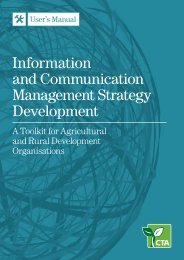Policy framework for Pastoralism in Africa
Policy framework for Pastoralism in Africa
Policy framework for Pastoralism in Africa
- No tags were found...
You also want an ePaper? Increase the reach of your titles
YUMPU automatically turns print PDFs into web optimized ePapers that Google loves.
issues, they are meant to br<strong>in</strong>g the issues of development closer to the people. These have broughtdesirable outcomes when they are matched with the correspond<strong>in</strong>g power and resources. Capacityissues need to be addressed if the process of political decentralisation is to br<strong>in</strong>g susta<strong>in</strong>able changeand development.c) Improved communication technologiesAlthough many advances <strong>in</strong> communication technologies have yet to reach pastoral areas, thereis little doubt that the expansion of mobile phone networks and mobile phone ownership is highlybeneficial <strong>for</strong> pastoralists. Pastoralists are becom<strong>in</strong>g better <strong>in</strong><strong>for</strong>med about local and <strong>in</strong>ternationalpolitical events, are better able to access market <strong>in</strong><strong>for</strong>mation, and can communicate more rapidlyand easier with relatives and traders, <strong>in</strong>clud<strong>in</strong>g <strong>in</strong>ternationally. The grow<strong>in</strong>g systems aroundremittances and migrations are also assisted by mobile phone communication. Increas<strong>in</strong>gly, theprivate sector is explor<strong>in</strong>g options <strong>for</strong> delivery f<strong>in</strong>ancial services, <strong>in</strong>clud<strong>in</strong>g bank<strong>in</strong>g, via mobilephones, with systems already <strong>in</strong> place <strong>in</strong> some countries. It follows that national policies on thecommunication sector are highly relevant to the development of pastoral areas.d) Food price <strong>in</strong>creases and f<strong>in</strong>ancial crisesBetween March 2007 and March 2008, global food prices <strong>in</strong>creased an average of 43 percent.Dur<strong>in</strong>g that period, wheat, soybean, maize and rice prices <strong>in</strong>creased by 146 percent, 71 percent,41 percent, and 29 percent respectively. Undoubtedly, ris<strong>in</strong>g food prices contributed to a significant<strong>in</strong>crease <strong>in</strong> food <strong>in</strong>security worldwide, particularly among poorer populations.These food price <strong>in</strong>creases impacted on pastoralists because <strong>in</strong> a typical year, they need to buy asubstantial proportion of their food needs <strong>in</strong> the <strong>for</strong>m of cereals. For some poorer pastoralists, upto 85 percent of food needs are acquired through direct purchase mean<strong>in</strong>g that food price <strong>in</strong>creaseshave a direct impact on food security. Although food prices started to fall <strong>in</strong> May 2009 due tovarious <strong>in</strong>terventions, food prices rema<strong>in</strong>ed high <strong>in</strong> most countries. Food emergencies result<strong>in</strong>gfrom the comb<strong>in</strong>ed effects of chronic food <strong>in</strong>security and high food price levels, persisted <strong>in</strong> 31countries.In response to the food price crisis, some <strong>Africa</strong>n countries are resort<strong>in</strong>g to the development ofagribus<strong>in</strong>ess which requires large land areas. Similarly, <strong>for</strong>eign countries are <strong>in</strong>vest<strong>in</strong>g <strong>in</strong> agribus<strong>in</strong>ess<strong>in</strong> <strong>Africa</strong> as a means to secure food supplies domestically. Cases of large scale land acquisitions<strong>in</strong> pastoral zones have been reported <strong>in</strong> relation to this trend, thereby add<strong>in</strong>g another cause of landloss to problems faced by pastoralists.The more recent global f<strong>in</strong>ancial crises probably had less direct impact on pastoralists, but <strong>in</strong>directimpacts would <strong>in</strong>clude reduced private sector <strong>in</strong>vestment, limited expansion of bank<strong>in</strong>g services<strong>in</strong>to pastoral areas, and reductions <strong>in</strong> official humanitarian or development aid.e) UrbanizationUrbanization is associated with both problems and opportunities <strong>for</strong> pastoralists. Urban centrespull people, especially young people, away from pastoral areas thereby, reduc<strong>in</strong>g the number ofpeople available <strong>in</strong> the pastoral <strong>for</strong>ce <strong>in</strong> some cases. Un<strong>for</strong>tunately, the low levels of education andSecur<strong>in</strong>g, Protect<strong>in</strong>g and Improv<strong>in</strong>g the Lives, Livelihoods and Rights of Pastoralist Communities27
















